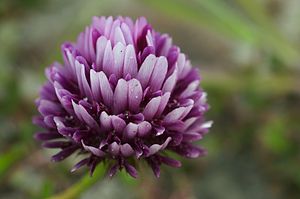Trifolium wormskioldii
| Trifolium wormskioldii | |
|---|---|

| |
| Scientific classification | |
| Kingdom: | Plantae |
| Clade: | Tracheophytes |
| Clade: | Angiosperms |
| Clade: | Eudicots |
| Clade: | Rosids |
| Order: | Fabales |
| Family: | Fabaceae |
| Subfamily: | Faboideae |
| Genus: | Trifolium |
| Species: | T. wormskioldii
|
| Binomial name | |
| Trifolium wormskioldii | |
| Synonyms[1] | |
|
List
| |
Trifolium wormskioldii is a species of clover[3] native to the western half of North America. Its common names include cows clover,[4] coast clover, sand clover, seaside clover, springbank clover,[5] and Wormskjold's clover.[3]
Description
Trifolium wormskioldii, a legume, is a perennial herb sometimes taking a matlike form, with decumbent or upright stems. The leaves are made up of leaflets measuring 1 to 3 centimetres (1⁄2 to 1+1⁄4 inches) long. The lower stipules are tipped with bristles and the upper stipules may be toothed.
The rounded inflorescences are 2 to 3 cm (3⁄4 to 1+1⁄4 in) wide. The sepals are bristle-tipped. The corollas are pinkish purple or magenta with white tips.[6]
Etymology
The species was given its scientific name in honour of the Danish botanist Morten Wormskjold.[7]
Distribution and habitat
This plant is native to the western half of North America from Alaska, through California, to Mexico. It is a perennial herb that grows in many locales, from beaches to mountain ridges, below about 3,200 metres (10,500 ft) in elevation.[6]
Habitats it grows in include chaparral, oak woodland, grassland, yellow pine forest, red fir forest, lodgepole forest, subalpine forest, and wetland−riparian.
Uses
Many Native American groups of western North America use this clover for food. The herbage and flowers are eaten raw, sometimes salted. The roots are commonly steamed or boiled and eaten with fish, fish eggs, and fish grease.[8]
This species is host to the caterpillar of the Western cloudywing butterfly (Thorybes diversus).[9]
References
- ^ "Trifolium wormskioldii Lehm". Plants of the World Online. Royal Botanic Gardens, Kew. Retrieved 31 August 2024.
- ^ NatureServe (2024). "Trifolium wormskioldii". Arlington, Virginia. Retrieved 30 August 2024.
- ^ 3.0 3.1 Trifolium wormskioldii. The Nature Conservancy.[dead link]
- ^ USDA, NRCS (n.d.). "Trifolium wormskioldii". The PLANTS Database (plants.usda.gov). Greensboro, North Carolina: National Plant Data Team. Retrieved 15 December 2015.
- ^ "Trifolium wormskioldii". Germplasm Resources Information Network. Agricultural Research Service, United States Department of Agriculture.
{{citation}}:|access-date=requires|url=(help) - ^ 6.0 6.1 Jepson T. wormskioldii
- ^ Charters, M. L. "wormskioldii". California Plant Names: Latin and Greek Meanings and Derivations.
- ^ Trifolium wormskioldii. Native American Ethnobotany. University of Michigan, Dearborn.
- ^ Thorybes diversus. Butterflies and Moths of North America.
External links
- Calflora Database: Trifolium wormskioldii (Coast clover, Cow clover, Springbank clover)
- Jepson Manual eFlora (TJM2) treatment of Trifolium wormskioldii
- USDA Plants Profile: Trifolium wormskioldii (cows clover)
- UC CalPhotos gallery: Trifolium wormskioldiiError: "Q5234176" is not a valid Wikidata entity ID.
- All articles with dead external links
- Articles with dead external links from August 2022
- Articles with invalid date parameter in template
- Short description with empty Wikidata description
- Commons category link is the pagename
- Trifolium
- Flora of the Northwestern United States
- Flora of the Southwestern United States
- Flora of Northeastern Mexico
- Flora of Northwestern Mexico
- Flora of Alaska
- Flora of British Columbia
- Flora of California
- Flora of New Mexico
- Flora of Texas
- Flora of the Sierra Nevada (United States)
- Natural history of the California chaparral and woodlands
- Natural history of the California Coast Ranges
- Natural history of the Peninsular Ranges
- Natural history of the Transverse Ranges
- Plants used in Native American cuisine